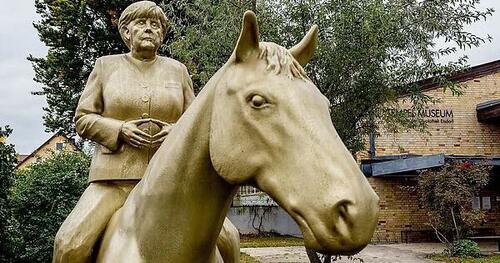
By Bas van Geffen and Elwin de Groot, strategists at Rabobank
Sometimes, art is more than just the canvas or sculpture. Many will probably remember the Banksy painting that –as soon as it was sold at auction– self-destructed by means of a paper shredder that was hidden in the frame.
When she left office after 16 years, a local museum unveiled a statue of Merkel on horseback to commemorate her reign. The artist left it to the viewer whether the statue was created out of appreciation or whether it was intended to be ironic. It drew plenty of ridicule at the time.
Last week, the statue collapsed under its own weight. As with most things done during the Merkel-era, the statue was built as efficiently as possible, but not very durable: it was hollow and 3D-printed out of concrete that could neither withstand the external forces of nature, nor support its own weight. This probably wasn’t intentional, but if it were it would be a brilliant artistic rendition of Merkel’s leadership and the aftermath the country is dealing with.
Since her leadership, European has seen supply chains collapse, with the future of German industry now at risk as EU leaders scramble to source more reliable sources of energy and inputs. And thanks to the lack of a German, or European, strategic global view, external forces like China have eroded away the continent’s power on the global stage and the competitiveness of Germany’s industrial engine: the car sector.
Post-Merkel, Europe has woken up, and pushed by Germany the Commission is investigating whether government subsidies are helping cheap Chinese EVs being dumped on the European market – though one can wonder why a probe into the matter is even necessary. A Bloomberg Opinion columnist argues today that China made –and subsidized– EVs should actually be welcomed by the EU, as it also lowers the price European consumers have to pay for their cars, and may therefore lower the cost of the energy transition. Well, obviously. But as we have repeated ad nauseam in this daily, the price of EVs and the likes is comprised of so much more than simply the monetary value of the product. Germany learned that lesson the hard way when the Russian gas supply got cut off.
The inflationary effects of the energy crisis haven’t even fully faded yet, as new commodity price increases are bringing renewed inflation risks to the fore. Oil prices continued to edge higher yesterday, with the nearest Brent future piercing through the $95/bbl level. Arguably, the key driver of this development has been the decision by Saudi Arabia and Russia in June to extend their production cuts. Speaking at the 5-day World Petroleum Congress in Calgary yesterday, Saudi energy minister Prince Abdulaziz bin Salman defended that decision, arguing that it was necessary to curtail volatility.
But there is more to it. Perhaps the perceived tightness of the market (which can be gauged from the backwardation in the market: futures prices trading lower than spot and nearest future prices) is also a sign that demand in some parts of the world, such as the US, has remained more resilient than expected just a while ago. Yet there are also structural forces, as our own energy analyst Joe DeLaura points out in a Webinar for Rabobank clients today. He basically sees 2010 to 2019 as an anomaly: a time of artificially low volatility and interest rates, and an oversupply of cheap energy. He believes a dramatic shift will mark the coming decade. Underinvestment in energy supply and infrastructure forms the basis of this new period of market volatility as humanity grapples with the clash between old fossil fuels and renewable energy. Worldwide investment in new oil and gas fields, gathering systems, refineries and exploration has dropped by over one-third. The relative oversupply of the 2010s kept volatility artificially low but that era is over, according to Joe. Oil and gas is a capital intensive business on the upstream side, so rising interest rates discourage new drilling, exploration and building gathering systems or refineries that take decades to pay back.
Meanwhile, climate change leads to a rising frequency of extreme weather conditions and is impacting things like peak electricity demand (this year’s scorching summer in several parts of the world also boosted demand for air conditioning), impairs nuclear cooling capacity and leads to hydroelectric power disruptions and transport challenges caused by low water levels in key hubs such as the German Rhine river and the Panama Canal.
In other words, higher fossil fuel prices are likely to be with us for the foreseeable future. That may be another incentive to accelerate investment in alternative energy sourced but is also likely to keep (energy) inflation more elevated during this transition. Global central banks, pay attention!
These developments drove some of the weakness in market sentiment. Equity markets slipped (Euro STOXX -1.15%), whilst European rates rose with a slight bear flattening move. The (modest) increase in risk aversion was visible in a slight widening of sovereign spreads.
The 10y US Treasury yield stayed within a whisker of its recent (post-pandemic) record of 4.337%, as concerns over a possible US government shutdown over the coming months are mounting again. Yes, we hear you thinking, “hang on a minute, I thought Republicans and Democrats had reached an agreement earlier this year, so what is this fuss all about?”
Well, as our US strategist Philip Marey points out, when the US debt limit was raised early June, it was assumed that a government shutdown later this year was averted as well. After all, the debt limit deal included sequestration in the form of a 1% cut in spending if all appropriations bills for fiscal year 2024 (which starts on October 1, 2023) are not passed by the end of this calendar year. This would surely encourage both parties to compromise on the necessary spending bills before December 31. However, we still need a continuing resolution to keep the government funded from October 1 until the end of the year or at least until agreement is reached on the budget for FY2024. Given the constructive bipartisan deal in June, a continuing resolution was supposed to be a stopgap measure that both parties would agree on. However, the House Freedom Caucus now wants something in return for a continuing resolution and this could be difficult to swallow for the Democrats. On Sunday, the Freedom Caucus and the more moderate Main Street Caucus came up with their own short term proposal, which would extend government funding until October 31. Yet, this proposal would cut discretionary spending levels by about 8% for most government programs, except defence and veterans programs, and will almost certainly be rejected in the Democrat-controlled Senate and thus cause a stalemate that could ultimately lead to a government shutdown on October 1. So, a deal that wasn’t a water-tight deal after all!
Closing yesterday’s European session, Reuters startled money markets with an unexpected article on possible future ECB policy tweaks. Several policymakers suggested that the minimum reserve requirement could be increased from 1% to as much as 4% of banks’ deposits. This would raise the minimum reserves to some €660 billion from the current €165, an amount that we believe is significant enough to pressure money market rates.
When the ECB stopped paying interest on minimum reserves, we speculated that more changes could be in the cards as the ECB is looking to cut the costs of its monetary policy. At the current deposit facility rate of 4%, the €495 billion increase would save the central bank €19.8 billion in interest costs annually. However, this would shift the burden of excess liquidity to banks, who, in turn, may decide to pass on these costs in the form of higher lending rates or a lower passthrough of rate hikes to the rate banks pay on customer deposits.
By Bas van Geffen and Elwin de Groot, strategists at Rabobank
Sometimes, art is more than just the canvas or sculpture. Many will probably remember the Banksy painting that –as soon as it was sold at auction– self-destructed by means of a paper shredder that was hidden in the frame.
When she left office after 16 years, a local museum unveiled a statue of Merkel on horseback to commemorate her reign. The artist left it to the viewer whether the statue was created out of appreciation or whether it was intended to be ironic. It drew plenty of ridicule at the time.
Last week, the statue collapsed under its own weight. As with most things done during the Merkel-era, the statue was built as efficiently as possible, but not very durable: it was hollow and 3D-printed out of concrete that could neither withstand the external forces of nature, nor support its own weight. This probably wasn’t intentional, but if it were it would be a brilliant artistic rendition of Merkel’s leadership and the aftermath the country is dealing with.
Since her leadership, European has seen supply chains collapse, with the future of German industry now at risk as EU leaders scramble to source more reliable sources of energy and inputs. And thanks to the lack of a German, or European, strategic global view, external forces like China have eroded away the continent’s power on the global stage and the competitiveness of Germany’s industrial engine: the car sector.
Post-Merkel, Europe has woken up, and pushed by Germany the Commission is investigating whether government subsidies are helping cheap Chinese EVs being dumped on the European market – though one can wonder why a probe into the matter is even necessary. A Bloomberg Opinion columnist argues today that China made –and subsidized– EVs should actually be welcomed by the EU, as it also lowers the price European consumers have to pay for their cars, and may therefore lower the cost of the energy transition. Well, obviously. But as we have repeated ad nauseam in this daily, the price of EVs and the likes is comprised of so much more than simply the monetary value of the product. Germany learned that lesson the hard way when the Russian gas supply got cut off.
The inflationary effects of the energy crisis haven’t even fully faded yet, as new commodity price increases are bringing renewed inflation risks to the fore. Oil prices continued to edge higher yesterday, with the nearest Brent future piercing through the $95/bbl level. Arguably, the key driver of this development has been the decision by Saudi Arabia and Russia in June to extend their production cuts. Speaking at the 5-day World Petroleum Congress in Calgary yesterday, Saudi energy minister Prince Abdulaziz bin Salman defended that decision, arguing that it was necessary to curtail volatility.
But there is more to it. Perhaps the perceived tightness of the market (which can be gauged from the backwardation in the market: futures prices trading lower than spot and nearest future prices) is also a sign that demand in some parts of the world, such as the US, has remained more resilient than expected just a while ago. Yet there are also structural forces, as our own energy analyst Joe DeLaura points out in a Webinar for Rabobank clients today. He basically sees 2010 to 2019 as an anomaly: a time of artificially low volatility and interest rates, and an oversupply of cheap energy. He believes a dramatic shift will mark the coming decade. Underinvestment in energy supply and infrastructure forms the basis of this new period of market volatility as humanity grapples with the clash between old fossil fuels and renewable energy. Worldwide investment in new oil and gas fields, gathering systems, refineries and exploration has dropped by over one-third. The relative oversupply of the 2010s kept volatility artificially low but that era is over, according to Joe. Oil and gas is a capital intensive business on the upstream side, so rising interest rates discourage new drilling, exploration and building gathering systems or refineries that take decades to pay back.
Meanwhile, climate change leads to a rising frequency of extreme weather conditions and is impacting things like peak electricity demand (this year’s scorching summer in several parts of the world also boosted demand for air conditioning), impairs nuclear cooling capacity and leads to hydroelectric power disruptions and transport challenges caused by low water levels in key hubs such as the German Rhine river and the Panama Canal.
In other words, higher fossil fuel prices are likely to be with us for the foreseeable future. That may be another incentive to accelerate investment in alternative energy sourced but is also likely to keep (energy) inflation more elevated during this transition. Global central banks, pay attention!
These developments drove some of the weakness in market sentiment. Equity markets slipped (Euro STOXX -1.15%), whilst European rates rose with a slight bear flattening move. The (modest) increase in risk aversion was visible in a slight widening of sovereign spreads.
The 10y US Treasury yield stayed within a whisker of its recent (post-pandemic) record of 4.337%, as concerns over a possible US government shutdown over the coming months are mounting again. Yes, we hear you thinking, “hang on a minute, I thought Republicans and Democrats had reached an agreement earlier this year, so what is this fuss all about?”
Well, as our US strategist Philip Marey points out, when the US debt limit was raised early June, it was assumed that a government shutdown later this year was averted as well. After all, the debt limit deal included sequestration in the form of a 1% cut in spending if all appropriations bills for fiscal year 2024 (which starts on October 1, 2023) are not passed by the end of this calendar year. This would surely encourage both parties to compromise on the necessary spending bills before December 31. However, we still need a continuing resolution to keep the government funded from October 1 until the end of the year or at least until agreement is reached on the budget for FY2024. Given the constructive bipartisan deal in June, a continuing resolution was supposed to be a stopgap measure that both parties would agree on. However, the House Freedom Caucus now wants something in return for a continuing resolution and this could be difficult to swallow for the Democrats. On Sunday, the Freedom Caucus and the more moderate Main Street Caucus came up with their own short term proposal, which would extend government funding until October 31. Yet, this proposal would cut discretionary spending levels by about 8% for most government programs, except defence and veterans programs, and will almost certainly be rejected in the Democrat-controlled Senate and thus cause a stalemate that could ultimately lead to a government shutdown on October 1. So, a deal that wasn’t a water-tight deal after all!
Closing yesterday’s European session, Reuters startled money markets with an unexpected article on possible future ECB policy tweaks. Several policymakers suggested that the minimum reserve requirement could be increased from 1% to as much as 4% of banks’ deposits. This would raise the minimum reserves to some €660 billion from the current €165, an amount that we believe is significant enough to pressure money market rates.
When the ECB stopped paying interest on minimum reserves, we speculated that more changes could be in the cards as the ECB is looking to cut the costs of its monetary policy. At the current deposit facility rate of 4%, the €495 billion increase would save the central bank €19.8 billion in interest costs annually. However, this would shift the burden of excess liquidity to banks, who, in turn, may decide to pass on these costs in the form of higher lending rates or a lower passthrough of rate hikes to the rate banks pay on customer deposits.
Loading…






